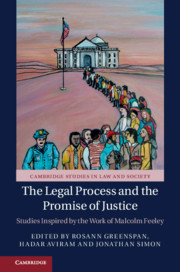Book contents
- The Legal Process and the Promise of Justice
- Cambridge Studies in Law and Society
- The Legal Process and the Promise of Justice
- Copyright page
- Contents
- About the Contributors
- Introduction: Past as Prologue
- Part I The Process Is the Punishment
- Part II Court Reform on Trial
- Part III Judicial Policymaking and the Modern State
- 10 Judicial Deference in the Modern State
- 11 The Law of the Workplace
- 12 Administrative “States” of Judicial Policy on Gender-Motivated Violence
- 13 Can Courts Abolish Mass Incarceration?
- 14 Policy-Making by Out-of-Court Settlements: Palestinian Informers at the Israeli High Court of Justice
- Part IV Political Liberalism and the Legal Complex
- Index
- Books in the Series
- References
12 - Administrative “States” of Judicial Policy on Gender-Motivated Violence
from Part III - Judicial Policymaking and the Modern State
Published online by Cambridge University Press: 18 April 2019
- The Legal Process and the Promise of Justice
- Cambridge Studies in Law and Society
- The Legal Process and the Promise of Justice
- Copyright page
- Contents
- About the Contributors
- Introduction: Past as Prologue
- Part I The Process Is the Punishment
- Part II Court Reform on Trial
- Part III Judicial Policymaking and the Modern State
- 10 Judicial Deference in the Modern State
- 11 The Law of the Workplace
- 12 Administrative “States” of Judicial Policy on Gender-Motivated Violence
- 13 Can Courts Abolish Mass Incarceration?
- 14 Policy-Making by Out-of-Court Settlements: Palestinian Informers at the Israeli High Court of Justice
- Part IV Political Liberalism and the Legal Complex
- Index
- Books in the Series
- References
Summary
In what sense is the rise of the modern administrative state a catalyst for judicial policymaking? Judicial Policy Making and the Modern State (1998), Malcolm Feeley and Edward Rubin’s treatise on judicial policymaking examines this dynamic in the context of prison reform litigation carried out by US federal courts in the mid to late twentieth century. Before 1965, federal judges had not reviewed the authority of prison wardens, who under the common law oversaw the implementation of internal prison practices. This changed after a judge in the US District Court for the Eastern District of Arkansas declared conditions of overcrowding at Cummins Frame State Prison “cruel and unusual punishment” in violation of the Eighth Amendment of the US Constitution.
- Type
- Chapter
- Information
- The Legal Process and the Promise of JusticeStudies Inspired by the Work of Malcolm Feeley, pp. 230 - 258Publisher: Cambridge University PressPrint publication year: 2019
References
Bibliography
Cases
Brzonkala v. Virginia Polytechnic Inst. & State University (1997) 132 F.3d 949, USCA 4th Circuit, vote 2–1.
Brzonkala v. Virginia Polytechnic Inst. & State University (1999) 169 F.3d 820, USCA 4th Circuit, en banc vote 7–4.
Civil Rights Cases (1883) 109 US 3; vote 8–1.
Griffin v. Breckenridge (1971) 403 US 88; vote 9–0.
U.S. v. Lopez (1995) 514 US 549; vote 5–4.
U.S. v. Morrison (2000) 529 US 598; vote 5–4.
Amici Curiae Brief of Law Professors in Support of Petitioners, U.S. v. Morrison, 120 S. Ct. 1740 (2000) (Nos. 99–5, 99–29).
U.S. Reply Brief, U.S. v. Morrison (1999).
Legislation
Violence Against Women Act (VAWA), 135 42 U.S.C. § 13981 (1994); (P.L. 103–322)
Violent Crime Control and Law Enforcement Act of 1994, PuB. L. No. 103–322, 108 Stat. 1796. 42 U.S.C.A. § 13981(b)-(c) (1995).



